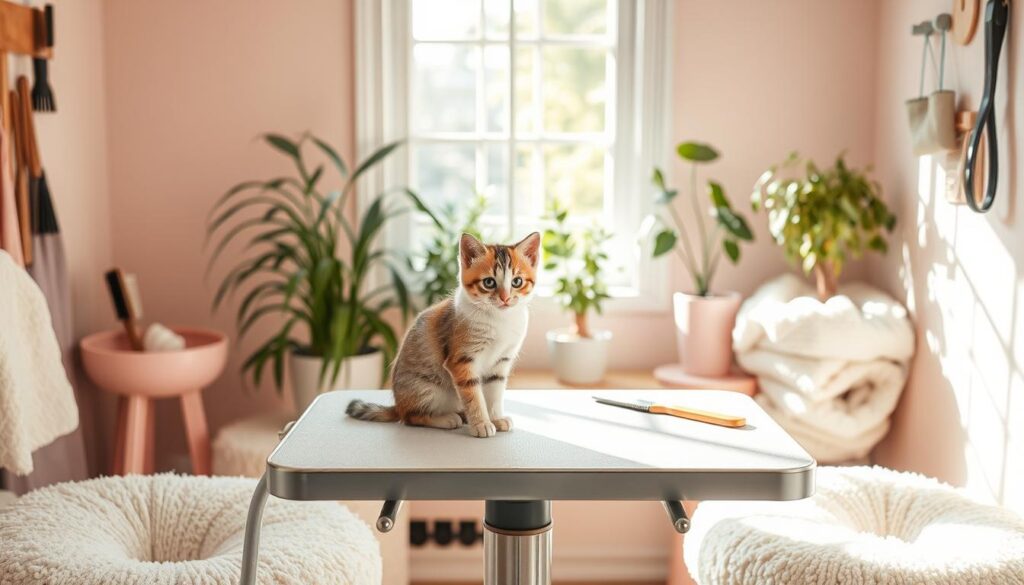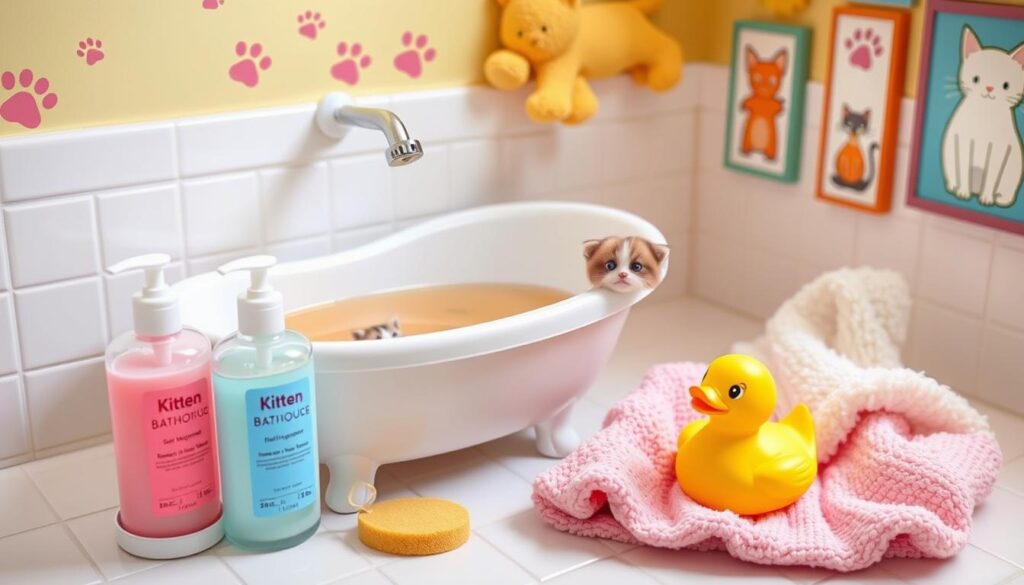As an Amazon Associate I earn from qualifying purchases.
Ever wondered why your kitten spends so much time grooming itself? Cats are naturally clean, but grooming is key to their health and happiness. Let’s explore kitten grooming essentials and how to help your kitten look and feel great.
Grooming your kitten is more than just keeping them clean. It’s a chance to connect with your pet, check on their health, and make sure they’re comfortable. Brushing and bathing are important for their coat, skin, and hygiene.
Each kitten is different, needing various grooming methods. Short-haired kittens might need brushing once a week, while long-haired ones might need it daily to avoid tangles. Knowing what your kitten needs helps you create a good grooming routine.
Regular grooming keeps your kitten looking good and helps spot health problems early. As you groom, you’ll get to know your kitten’s body well. This can help you catch any unusual lumps or skin changes early.
Grooming can also help prevent hairballs. By brushing your kitten, you remove loose fur they might swallow. This can stop hairballs and digestive problems. Adding kitten grooming essentials to your routine has many benefits.
Key Takeaways
- Regular grooming maintains coat health and prevents skin issues
- Different coat types require specific grooming tools and techniques
- Grooming helps in early detection of health concerns
- Brushing reduces hairballs and shedding
- Establishing a grooming routine strengthens the bond with your kitten
- Professional groomers can offer specialized care for complex needs
- Dental care is crucial for preventing periodontal disease in cats
Understanding Your Kitten’s Coat and Grooming Needs
Grooming your kitten is key for their health and happiness. Each kitten has different coat types that need special care. Knowing these needs helps you create a good grooming routine.
Different Coat Types and Their Requirements
Kittens have many coat types, each needing its own care:
- Long-haired: Daily brushing prevents mats and tangles
- Short-haired: Weekly brushing suffices, reducing hairball risks
- Hairless: Regular baths maintain skin health
- Double-coated: Frequent grooming prevents knots
Choosing the right kitten brushes is crucial. Bristle brushes are great for short-haired kittens. Slicker brushes are better for long-haired ones. For double-coated kittens, use moulting combs to manage shedding.
Age-related Grooming Considerations
Your kitten’s grooming needs change as they grow:
- Kittens: More frequent grooming due to playful exploration
- Adult cats: Established routines with less intensive grooming
- Senior cats: Extra assistance due to reduced mobility
Establishing a Grooming Routine
Creating a consistent grooming routine helps with coat health and bonding. Start with short sessions and use treats for positive reinforcement. As your kitten gets used to it, you can increase the time spent grooming. Remember, grooming is more than just about looks – it’s a way to strengthen your bond with your furry friend.
| Coat Type | Brushing Frequency | Recommended Tools |
|---|---|---|
| Long-haired | Daily | Slicker brush, Moulting comb |
| Short-haired | Weekly | Bristle brush |
| Hairless | Weekly skin check | Soft cloth |
| Double-coated | 2-3 times weekly | Undercoat rake, Slicker brush |
Understanding your kitten’s coat type and grooming needs is key. With the right routine, you’ll have a healthy, happy, and well-groomed kitten.
Essential Kitten Grooming Tools
Grooming your kitten is key to their health and happiness. The right tools make grooming easy and fun for you and your kitten. Let’s look at the must-have items for your kitten’s grooming kit.
Begin with a metal comb for long-haired kittens or a rubber brush for short-haired ones. These tools help remove loose fur and prevent matting. The Frisco Cat and Dog Pin Bristle Brush is great for all coat types. For kittens that like being petted, a grooming mitt is a good choice.
A good kitten shampoo is a must for bath time. The Hepper Colloidal Oatmeal Pet Shampoo is made in the USA and is gentle on your kitten’s skin. The National Cat Groomers Institute of America suggests bathing a cat every 4-6 weeks.
Don’t overlook nail care! Kitten nail clippers, like the JW Pet Gripsoft Cat Nail Clippers, are perfect for small paws. They have easy-grip handles and keep your kitten’s nails at a comfortable length.
- Ear cleaner (Virbac Epi-Otic Advanced Ear Cleaner)
- Toothbrush and toothpaste (CET Dog and Cat Poultry-flavored Toothpaste and Toothbrush Kit)
- Flea comb
- Styptic powder
- Towels
- Treats for positive reinforcement
With these tools, you’ll be ready to keep your kitten clean, healthy, and happy. The ASPCA suggests brushing your kitten at least twice a week. Long-haired kittens need daily brushing.
Creating a Calm Grooming Environment
Creating the perfect grooming space for your kitten is key for a stress-free experience. Your kitten’s comfort should be your main focus. Let’s look at how to make grooming a calm experience for your kitten.
Choosing the Right Location
Find a quiet spot in your home for grooming. A peaceful bathroom or spare room is ideal. Make sure it’s away from loud noises and other pets. This makes your kitten feel safe and calm during grooming.
Setting Up Your Grooming Station
Get your grooming station ready with care. Keep all tools like brushes, combs, nail clippers, and treats within reach. A non-slip mat on a sturdy table gives your kitten a secure place to stand.

Using Positive Reinforcement
Make grooming a good experience for your kitten. Use treats and gentle praise for good behavior. This links grooming to positive feelings. Begin with short sessions and slowly make them longer as your kitten gets used to it.
| Kitten Grooming Safety Tips | Benefits |
|---|---|
| Use cat-specific products | Prevents skin irritation |
| Keep sessions short | Reduces stress |
| Monitor body language | Avoids overstimulation |
| Provide breaks | Maintains a calm atmosphere |
Remember, patience is key when creating the ideal kitten grooming environment. With time and consistency, your kitten will learn to enjoy these moments with you.
Brushing and Combing Techniques for Kittens
Learning how to brush your kitten is crucial for their coat’s health and beauty. Regular grooming removes dirt and tangles. It also prevents hairballs and helps spot skin issues early.
Short-haired kittens can be brushed with a metal comb from head to tail. Long-haired kittens need extra care. Start with their belly and legs, then comb up towards their head. This stops mats from forming in tricky spots.
Choosing the right kitten deshedding tools makes grooming easier. Slicker brushes are good for removing loose hair and debris. Pin brushes are better for longer coats. Always brush in the hair’s growth direction to avoid skin irritation.
Brush your kitten once or twice a week. Long-haired kittens might need more frequent brushing to avoid mats. Use gentle strokes and give treats to make grooming fun.
“Regular grooming allows for the early detection of health issues such as lumps, injuries, fleas, and skin irritations.”
By using these brushing techniques, you’ll keep your kitten looking good and strengthen your bond. These moments together are nurturing.
Bathing Your Kitten: When and How
Kitten bathing is key to their grooming, but it’s not needed often. Kittens usually need baths every four to six weeks, unless they get dirty or have health issues. Your vet can tell you the best schedule, especially if your kitten has skin problems or allergies.
Preparing for Bath Time
Before bathing your kitten, get your supplies ready. You’ll need lukewarm water, kitten shampoo, and soft towels. Pick a quiet spot where your kitten feels safe. For a first-time bath, consider using dry pet shampoo or kitten grooming wipes to make it easier.

Step-by-Step Bathing Process
Fill a sink or small tub with lukewarm water. Carefully put your kitten in the water, making sure to support their body. Use a cup to pour water over them, skipping their ears and eyes. Add a little kitten shampoo and lather it up. Rinse well to avoid skin irritation. Remember, be patient – some kittens may not like getting wet!
Drying and Post-Bath Care
Wrap your kitten in a warm towel and dry them gently after the bath. Kittens can get cold fast because they don’t have much fat. Keep them in a warm spot. If they can handle it, use a low-heat blow dryer. Treats and praise after the bath will help them associate it with something good.
| Bathing Frequency | Water Temperature | Safety Measures |
|---|---|---|
| Every 4-6 weeks | Lukewarm | Keep ears and eyes dry |
| As needed for health/hygiene | Avoid cold water | Constant supervision |
| Consult vet for specific needs | Test water before use | Use kitten-safe products |
If you’re unsure about bathing your kitten, call a professional cat groomer. They can give you tips and make sure the bath is safe and stress-free for your kitten.
Kitten Grooming Essentials: Nail Care and Trimming
Keeping your kitten’s nails trimmed is key for their health and your furniture’s safety. You should trim their nails every three to four weeks. This keeps their nails at the right length.
Get kitten nail clippers made just for cats. They make trimming safer and easier. Hold your kitten gently and carefully extend each claw. Don’t cut the quick, which is the pink part inside the claw.
- Take breaks if your kitten becomes restless
- Offer treats and praise for positive reinforcement
- Start with one paw at a time to build trust
Be patient when you start trimming your kitten’s nails. Doing it early makes grooming a good experience for both of you. With practice, you’ll get really good at it!
“Regular nail trimming keeps your kitten happy and your home scratch-free.”
| Nail Care Benefits | Frequency |
|---|---|
| Prevents furniture damage | Every 3-4 weeks |
| Maintains paw health | Monthly check-ups |
| Reduces accidental scratches | As needed |
Ear and Dental Care for Your Kitten
Keeping your kitten’s ears and teeth clean is key for their health. Let’s look at safe ways to care for these important areas.
Cleaning Your Kitten’s Ears Safely
Cleaning your kitten’s ears needs patience and care. Use a special ear cleaner made for kittens and soft cotton balls. Gently wipe the outer ear, but don’t go inside the ear canal. Cleaning their ears once a week can stop infections and keep them happy.
Introducing Dental Hygiene Habits
Good dental care is vital for your kitten’s health. Start with a toothbrush and toothpaste made just for cats. Brush their teeth in circles, paying attention to the gums and outer surfaces. Try to brush their teeth every day to fight plaque and keep their breath fresh.
| Care Type | Frequency | Tools Needed |
|---|---|---|
| Ear Cleaning | Weekly | Ear cleaning solution, cotton balls |
| Teeth Brushing | Daily | Cat toothbrush, cat toothpaste |
Being consistent with kitten grooming is important. By starting these ear and dental care routines early, you’re helping your kitten develop good health habits for life.
Addressing Common Skin and Coat Issues in Kittens
Kittens can face skin problems that make them uncomfortable. Regular grooming is key to spotting issues early. Use kitten grooming gloves to check for fleas, ticks, and ear mites while spending quality time with your pet. A flea comb is great for removing parasites and their waste, keeping your kitten’s coat in top shape.
Kitten coat issues can come from many sources. Flaky skin, ringworm, or allergies need quick action. If you see any strange signs, talk to your vet for the right diagnosis and treatment. About 15% of cats get skin conditions that need special care.
What your kitten eats is crucial for their skin and coat health. Feed them a balanced diet full of omega-3 fatty acids. This helps keep their coat shiny and reduces inflammation. Taking this step can prevent many common skin issues.
Top Skin Conditions in Kittens
- Flea allergy dermatitis
- Allergic dermatitis
- Ringworm
- Dry skin
- Superficial pyoderma
Look out for signs like too much scratching, hair falling out, or skin color changes. Catching these early and treating them is crucial for your kitten’s comfort and health. With the right care and attention, you can help your kitten have a beautiful, issue-free coat.
Conclusion
Grooming your kitten is more than just keeping them clean. It’s key to their health and strengthens your bond. Regular grooming sets the stage for a healthy life for your cat.
Every kitten is different, and so are their grooming needs. Long-haired kittens need daily brushing to avoid tangles. Short-haired kittens do well with weekly grooming. Adjust your grooming to fit your kitten’s needs for a shiny coat and a happy cat.
Start grooming your kitten early to make it a positive experience. Use treats and praise to make them enjoy it. Include nail trimming, ear cleaning, and dental care in your routine. These practices keep your kitten looking good and help spot health issues early.
Spending time grooming your kitten makes them a happy, healthy friend. Enjoy this special time with your kitten. Watch as your bond grows stronger with every brush stroke.
FAQ
What are the essential grooming tools for kittens?
How often should I brush my kitten?
How do I create a calm grooming environment for my kitten?
When should I bathe my kitten?
How often should I trim my kitten’s nails?
How do I clean my kitten’s ears?
How do I introduce dental hygiene habits for my kitten?
What common skin and coat issues should I watch for in kittens?
As an Amazon Associate I earn from qualifying purchases.

